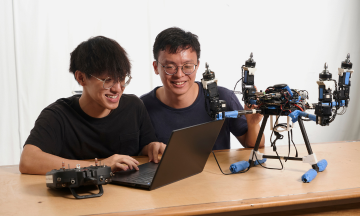Autonomous Vehicle and UAV Robotics

There is still a long way to go before artificial mini robots are really used for search and rescue missions in disaster-hit areas due to hindrance in power consumption, computation load of the locomotion, and obstacle-avoidance system. Insect–computer hybrid system, which is the fusion of living insect platform and microcontroller, emerges as an alternative solution. This study demonstrates the first-ever insect–computer hybrid system conceived for search and rescue missions, which is capable of autonomous navigation and human presence detection in an unstructured environment. Customized navigation control algorithm utilizing the insect’s intrinsic navigation capability achieved exploration and negotiation of complex terrains. On-board high-accuracy human presence detection using infrared camera was achieved with a custom machine learning model. Low power consumption suggests system suitability for hour-long operations and its potential for realization in real-life missions.
Principal Investigator: Professor Hirotaka Sato
The objective is to leverage human cognition mechanism to codesign prediction and decision-making for AVs.
- Interaction-aware prediction
- Differentiable Integrated Prediction and Planning
Principal Investigator: Associate Professor Lyu Chen
The objective is to leverage multi-modal LLM to enhance the scene understanding and decision-making for AVs and robotics.
- Knowledge augmented e2e driving with Large Language Model
- LLM-enabled robotic manipulation with skill learning
Principal Investigator: Associate Professor Lyu Chen
The objective is to develop multi-modal embedded intelligence for designing multi-modal robotics in various domains.
- Autonomous F1 racing car
- Autonomous flying car
- Autonomous Mobile Manipulator
Principal Investigator: Associate Professor Lyu Chen
- Adaptive Flight Control - Custom algorithms ensure seamless transitions between vertical hover and forward cruise, delivering smooth, stable flight in Singapore's urban airspace.
- Fault-Tolerant Architecture - Redundant sensing and real-time health monitoring keep the aircraft controllable under component failures, meeting stringent safety standards for passenger operations.
- High-Fidelity Digital Twin - Hardware-in-the-loop and full 6-DoF simulation accelerate controller tuning, safety validation, and certification readiness for Singapore's eVTOL routes.
Principal Investigator: Assistant Professor Mir Feroskhan
ParcelDrone: A Self-Configuring Aerial Delivery Platform for Scalable Urban Logistics
- Modular Design - Transforms the parcel into the drone airframe using plug-and-fly propeller units with integrated motors, batteries, and controllers for rapid, scalable assembly.
- Energy-Efficient Descent - Recovers energy during free-fall through a custom wind-harvesting circuit.
- Decentralized Intelligence - Employs a learning-based control system for robust, autonomous coordination across varying payload shapes, sizes, and centers of gravity.
Principal Investigator: Assistant Professor Mir Feroskhan
AI-Powered Morphing Hummingbird Drone
- Bio-Inspired Morphing Airframe - Flexible wings and coordinated wing-tail morphing replicate hummingbird mechanics, enabling silent hovering and rapid manoeuvres in cluttered environments.
- Physics-Informed AI Modelling - A learning based framework captures unsteady aerodynamics and wing-tail interactions, delivering high-fidelity dynamics without large labelled datasets.
- Agile, Wind-Resilient Control - Gain-scheduled controllers derived from the learned model provide stable hover and swift attitude changes, advancing drone capabilities for sensitive biodiversity missions.
Principal Investigator: Assistant Professor Mir Feroskhan
Drone Swarm Navigation in GNSS-Denied Environments
- Localization & Perception - Each drone fuses LiDAR, vision, IMU and UWB data to self-localise and map in real time even when GPS is unavailable.
- Safe-Agility Planner - A hierarchical planner couples deep-RL-driven agility limits with provably safe convex optimisation, producing smooth, collision-free paths that adapt speed and aggressiveness to local obstacle density on the fly.
- Rapid Morphing Swarm Formation - An event-triggered formation system treats the swarm as one deformable body, recalculating its geometry in milliseconds so the group can compress, expand or rotate to slip through tight gaps while maintaining cohesion.
Principal Investigator: Assistant Professor Mir Feroskhan
Reimagining Space Situational Awareness with Onboard AI
- Satellite-Integrated Vision - Multi-view cameras and AI detection on smart microsatellites track even tiny debris over a broad area, removing reliance on ground telescopes and radars.
- Edge-AI Orbit Analytics - Lightweight neural models running on minimal onboard power deliver real-time orbit determination and propagation with high precision, sharply reducing bandwidth use and ground-link delays.
- Scalable, Site-Free Solution - Readily deployable on single satellites or constellations, the system offers a patent-ready, cost-effective Space Situational Awareness capability ideal for land-scarce nations.
Principal Investigator: Assistant Professor Mir Feroskhan

